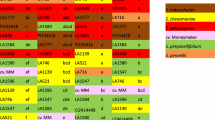Abstract
Laboratory, greenhouse and field experiments were conducted to identify plant accessions of the genusLycopersicon and ofSolarium pennellii resistant toSpodoptera littoralis (Boisd.),Plusia chalcites (Esp.),Heliothis armigera (Hbn.), andPhthorimaea operculella (Zeu.), four insect pests of the cultivated tomato. Percent survival, larval weight, duration of development, damage scores, etc., were the criteria used to determine the relative resistance of the examined accessions. TheL. hirsutum accession LA 1777 and theL. hirsutum f.glabratum accession LA 407 were found to be highly resistant to all four insect pests. TheS. pennellii accession LA 716 was found to be resistant to the first three insects, but only partially resistant toP. operculella. The possible mechanisms of resistance,i.e., the physical entrapment of larvae and the toxic action of phytochemicals in the various accessions, are discussed.
Similar content being viewed by others
References
Avidov, Z. and Harpaz, I. (1969) Plant Pests of Israel. Israel Universities Press, Jerusalem.
Clayberg, C.D. and Kring, J.B. (1974) Breeding tomatoes resistant to potato aphid and white fly.HortScience 9: 297 (abstr.).
Gentile, A.G. and Stoner, A.K. (1968) Resistance inLycopersicon andSolatium species to the potato aphid.J. econ. Ent. 61: 1152–1154.
Gentile, A.G. and Stoner, A.K. (1968) Resistance inLycopersicon spp. to the tobacco flea beetle.J. econ. Ent. 61: 1347–1349.
Juvik, J.A. (1980) Assessment of the alkaloid, α-tomatine as a potential source of natural insect resistance in tomato cultivars. Ph.D. thesis, University of California, Davis, CA.
Rivnay, E. (1962) Field Crop Pests in the Near East.in: Weisbach, W.W. [Ed.] Mono-graphiae Biologicae. Vol. 10. Dr. W. Junk, Den Haag.
Schalk, J.M. and Stoner, A.K. (1976) A bioassay differentiates resistance to the Colorado potato beetle on tomatoes.J. Am. Soc. hort. Sci. 101: 74–76.
Schuster, D.J. (1977) Resistance in tomato accessions to the tomato pinworm.J. econ. Ent. 70: 434–436.
Webb, R.E., Stoner, A.K. and Gentile, A.G. (1971) Resistance to leaf miners inLycopersicon accessions.J. Am. Soc. hort. Sci. 96: 65–67.
Williams, W.G., Kennedy, G.G., Yamamoto, R.T., Thacker, J.D. and Bordner, J. (1980) 2-tridecanon: A naturally occurring insecticide from the wild tomatoLycopersicon hirsutum f.glabratum.Science 207: 888–889.
Author information
Authors and Affiliations
Rights and permissions
About this article
Cite this article
Juvik, J.A., Berlinger, M.J., Ben-David, T. et al. Resistance among accessions of the generalycopersicon andsolanum to four of the main insect pests of tomato in Israel. Phytoparasitica 10, 145–156 (1982). https://doi.org/10.1007/BF02994524
Received:
Issue Date:
DOI: https://doi.org/10.1007/BF02994524




